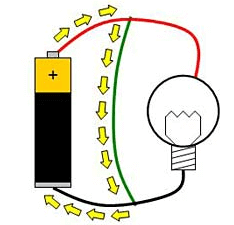Short Circuit, Open Circuit, Closed Circuit are fundamental concepts in the study of electrical circuits. Understanding these terms is crucial for anyone learning about how electricity flows and behaves in different conditions. A circuit refers to a closed loop that allows electric current to travel. Without a complete and closed path, electricity cannot flow properly, leading to specific circuit behaviors such as short circuits, open circuits, and closed circuits. In this article, we will dive deep into the definitions, working principles, and real-life examples of each type of circuit.
Before understanding short circuits, open circuits, and closed circuits, we need to know what a circuit is. A circuit is generally a closed loop through which electric current can flow. To have electric current flow, a source (battery/AC source) is necessary.

Looking at the circuit above, you can see that it is a complete circuit. In the circuit, there is a battery source and a load (a light bulb).
Short Circuit:
Explanation: Imagine in your mind a 5-foot-high water-filled drum and assume the drum is full of water, and the water is flowing down from the drum to the ground. In other words, water is flowing down from the height of 5 feet to the ground.
Since the height of the drum is 5 feet, the water must travel a distance of 5 feet to reach the ground. Now, if you create a hole in the wall of the drum at a height of 3 feet from the ground, the water will stop falling from the 5-foot height and will instead start flowing out from the 3-foot hole to the ground.
Observe:
(1) Initially, when the water was flowing from the top of the drum to the ground, it had to cover a distance of 5 feet (since the height of the drum is 5 feet).
(2) But after you made the hole 3 feet from the ground, the water now only has to travel 3 feet to reach the ground.
So, we can see here that the water chose the shorter and easier path, abandoning the longer 5-foot route in favor of the shorter 3-foot one. All natural phenomena follow this same principle. Everything, including water, electricity, and light, always seeks the easiest path to reach its destination, and even you and I are no exception.
Electricity in a circuit is supposed to follow a specific path, but if that path gets shortened for any reason, the electricity will choose the shorter path, leading to a short circuit.
Let me explain more clearly:
In my example, when water was falling from the 5-foot height of the drum, its speed was lower because the water pressure at the top of the drum was less. We know that water pressure increases with depth. That’s why when you made a hole 3 feet from the ground, the water pressure increased, and the water started flowing to the ground faster than before. When the pressure or water flow increases, a larger amount of water can flow out in a shorter time.
The same principle applies to electricity. Voltage is known as the pressure of electricity. If the voltage increases, a larger amount of electrons can flow out in a short time, meaning the current increases. This is exactly like the example of the water drum.
When the current in a circuit increases, the wires of the circuit start to heat up, meaning that the current overloads the wire. When the current continues to increase many times above normal levels, the excessive load on the wire causes it to burn or spark. This is what we commonly refer to as a short circuit in our daily lives.

If you connect the positive and negative terminals of a battery with a small wire, you will see sparking, which is a common example of a short circuit. Theoretically, a short circuit means that the impedance of the wire drops to zero, allowing the electric current to flow without resistance.
Theoretical Analysis: “Short” is an English word meaning brief or small. “Short circuit” refers to a connection between any two terminals of a circuit through a conductor with very low resistance. As a result, a large current flows through the short connection, and sometimes the power source itself can burn out.
Open Circuit:
“Open” means something that is not closed. An open circuit is an electric circuit where the continuous flow of current is interrupted.

When you turn on a circuit with a switch, it becomes a closed circuit, and when you turn it off, it becomes an open circuit. The above circuit is an open circuit where current cannot flow. If a wire in a circuit breaks for any reason, electricity can no longer flow through it. In this case, the resistance of the circuit becomes infinite, and we say the circuit is open.
Closed Circuit:
“Closed” is an English word meaning sealed or shut. An ideal circuit is known as a closed circuit. A closed circuit is a circuit where current can flow continuously without interruption.

In other words, an open circuit is one where the current cannot flow, while a closed circuit is one where the current can flow, keeping the load operational.
What is the difference between an open circuit and a short circuit test?
An open circuit test measures the voltage when no current flows through the circuit, while a short circuit test checks how much current flows when the circuit is closed with very low resistance.
Can you explain the difference between open circuit and short circuit diagrams?
In an open circuit diagram, there’s a break in the path, so no current flows. In a short circuit diagram, the current bypasses the main load, following a path of minimal resistance.
What are some examples of an open circuit?
Examples of an open circuit include a light switch turned off, a broken wire, or an unconnected battery terminal.
What is a short circuit?
A short circuit occurs when electricity takes an unintended, low-resistance path, bypassing the main circuit, which can cause excessive current and potential damage.
What is the difference between an open circuit and a closed circuit?
An open circuit has a break that prevents current from flowing, while a closed circuit is a complete path that allows current to flow continuously.
What is the resistance of an open circuit?
The resistance of an open circuit is theoretically infinite because no current flows through it.
What is open circuit voltage?
Open circuit voltage refers to the electrical potential difference between two points when no current is flowing through the circuit.



